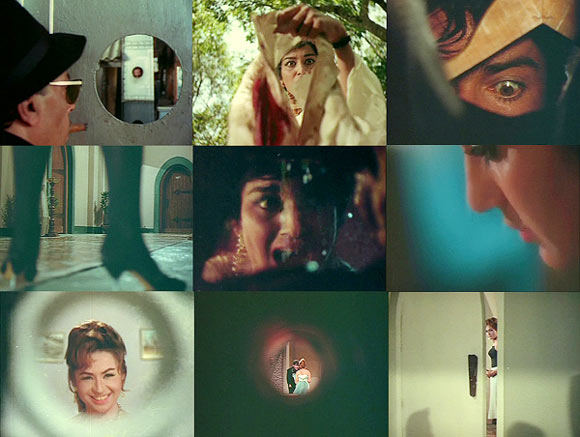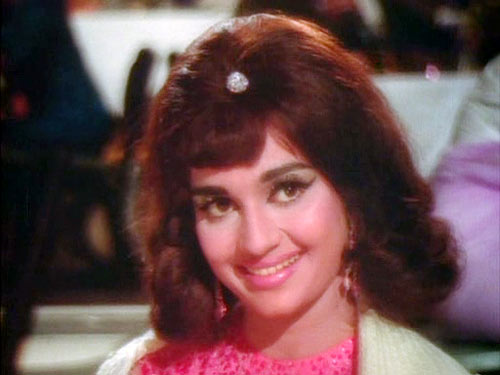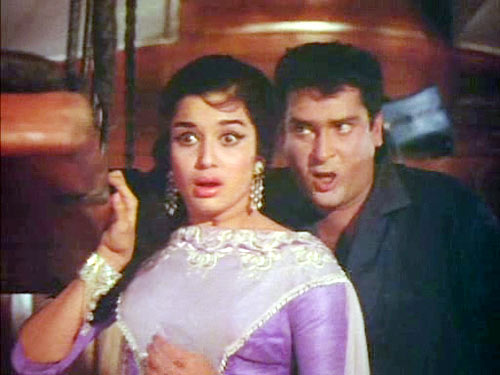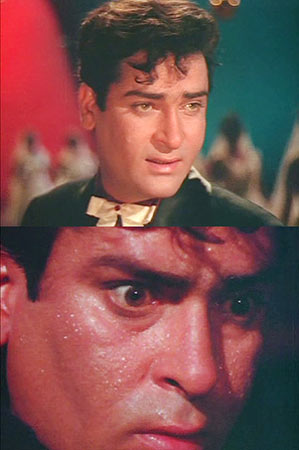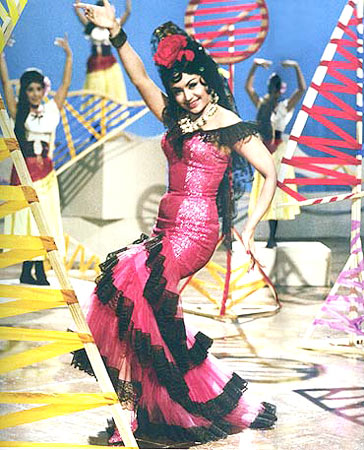 | « Back to article | Print this article |
Teesri Manzil: Style, substance, Suspense and Shammi!
Can you imagine Teesri Manzil without Shammi Kapoor? Me? Not even hypothetically. But the truth is that filmmaker Nasir Husain originally conceptualised the classic mystery with Dev Anand in mind.
The two had previously worked on Jab Pyaar Kisise Hota Hai and hit it off but a disagreement ruined any chance of a reunion for another project.Husain then approached his star of films like Tumsa Nahi Dekha and Dil Deke Dekho who insisted on and got, a verbal no-objection from Devsaab before getting on board.
The film may have 'fallen in his lap' but Teesri Manzil turned into something special for him and everyone associated with it in ways they could not have imagined. From inspiring parodies and tributes in films like Chashme Buddoor (the original), Om Shanti Om and quite possibly the upcoming Yeh Jawaani Hai Deewani, to hugely influencing the entire suspense genre, the 1966 box office smash is a true embodiment of the old cliche -- old wine that gets better with time.
The unmistakable razzle-dazzle in Husain's films is definitive of what the great Indian celluloid dream is all about -- vibrant spectacle of matinee idols, unflinching showmanship, charismatic melodies, frothy romance, fanciful but persuasive narrative and incredibly sleek technique.
Husain, who produced as well as wrote the story, screenplay and dialogues of Teesri Manzil delivers a masterstroke by bringing in the discerning Vijay 'Goldie' Anand to helm one of our most flawless entertainers -- a stylish whodunit along the lines of Alfred Hitchcock embellished with a splendid show of song, dance and romance in Eastman colour.
Why R D Burman did the score
Following the critically-acclaimed Guide, Goldie began work on his first film without Dev Anand.
He flexes his range in an intrigue-filled premise with flair employing his leading actors' ebullient chemistry to balance the darker elements of the story. Being the editor comes in handy; it's his compact vision that goes a long way in lending Teesri Manzil a taut, crisp bearing.
It's the ideal combination of Husain's indulgent and Goldie's thrifty approach.
Speaking of perfect combinations, Teesri Manzil has quite to boast of. Right from Husain regulars -- Shammi Kapoor, Asha Parekh, Helen, Rahul Dev Burman, Majrooh Sultanpuri to Kapoor-Rafi, Kapoor-Helen, RD-Asha Bhosle.
Interestingly, RD, too, almost didn't do the soundtrack, considered to be a milestone in his career. Initially, Kapoor was reluctant to have RD and preferred his regulars Shankar-Jaiskishen but once he heard what the baby-faced composer had to offer, he was sold.
In an interview to Filmfare, the music director recalled the star's words to him, 'I don't want to hear any more songs, you've passed.'
Pehli, Doosri and Teesri Manzil
The glossy treatment dominating all the departments -- sets, choreography, fashion, cinematography, music would be half as effective if the screenplay didn't roll out as deftly as Vijay Anand's direction.
At the onset, as a girl jumps to her death from the third floor of a posh Mussoorie hotel, we witness a disturbed Shammi Kapoor, a slyly smiling Helen and a startled Prem Chopra.
Cut to a year later, the girl's younger sister Sunita (Asha Parekh) sets out on a train journey to Dehradun to probe further since she believes her sister was raped by the hotel drummer named Rocky leading to her suicide.
A series of comic flirtations and banter between Sunita and a young man (Kapoor) follow, over a rotund passenger's uncontrollable urge to giggle. The man laughs so hard, you'd think he'll pass out. And he does.
Of course, the heroine is easily duped into believing he's dead and the hero suddenly appears the epitome of all things kind and considerate before she eventually discovers the truth and they're back to square one. Their on-screen attraction between the perky 35-year-old and his 11 years younger leading lady is almost tangible and seamless.
There's a delightful moment between them which alludes to the film's title in a manner dramatically different from its opening scene. Kapoor, who conceals his true identity of Rocky by introducing himself as Anil/Sona, tells a doe-eyed Parekh what his grandfather always said, 'Beta milaap ki teen manzilein hoti hain. Pehli manzil – nafrat aur ladaai. Doosri manzil – dosti aur safaai. Teesri manzil -- pyaar aur sagaai.'
The songs of Teesri Manzil
Romance gradually blooms after he skilfully dodges her brute force of hockey stick-armed girls and rescues her from a bunch of creepy goons in the middle of a forest on a stormy night proving himself to be a nice, noble and natty fella.
Their vivacious camaraderie is build around RD's epic compositions, Majrooh Sultanpuri's wow-inducing ardour (Ishq hoon main kahin theherta hi nahin, Aage hai qatil mera aur mein peeche peeche) and Mohammad Rafi-Asha Bhosle's full-bodied rendition. Let's see:
O mere sona re – the best-ever make-up song where a bag's strap acts as a catalyst between the two. (One experiences a sense of deja vu at the interaction of Aamir Khan and Juhi Chawla during Gazab ka hai din in Husain's 1988 production, Qayamat Se Qayamat Tak.)
Deewana mujhsa nahi – of close-ups, shy glances and melting smiles.
Main inpe marta hoon – the dizzy ditty picturised on a speeding Ferris wheel and merry-go-round.
Aaja aaja – the wacky stutter of a song where twist meets freestyle meets rock 'n' roll.
Tumne mujhe dekha – when Teesri Manzil is at its most emotional and vulnerable stage.
O haseena zulfonwali – against its grand set, a resplendent and nimble Helen complements Kapoor's vigorous shimmy.
It cannot be said emphatically enough but every single song unfolds like a dream.
The Players
Set in a hotel with an active musical band, Teesri Manzil has valid excuse to play out magnificent performances featuring the glittering Helen in one of her most alluring avatars as Ruby.
In most scenes, she appears like a sinister (and sizzling) version of the grinning Cheshire cat before Shammi and purrs out some delicious riddles before fading into the corridors of the luxury hotel.
All the songs, with the exception of the slightly out of place Main inpe marta, are introduced to forward the narrative which is punctuated by a cigar-puffing Iftekar's sleuth-like shadow.
Vijay Anand carefully turns the light-hearted mood around when Kapoor comes into his room to find it completely ransacked. When he suspects someone eavesdropping outside, he immediately steps out to check only to find a cloud of smoke left behind someone who was right there moments before.
From this point onwards begins an absorbing game of clues, suspects and motives in anticipation of the big reveal.
While Kapoor would be the most obvious pick since he's already on the defensive, others like the victim's threatening fiance (Prem Chopra), the deceitful steward (Rashid Khan), the jealous dancer (Helen) and a friendly aristocrat (Premnath) begin to surface as suspects. There's KN Singh in a fleeting cameo of a drunkard but serves little beyond the obligatory red herring.
The link between Teesri Manzil and Caravan
Vijay Anand, who followed this up with another gripping thriller Jewel Thief, tells you what makes him the master of intrigue. Though clearly derivative of the Hitchcockian attributes (camerawork, humour, tension) the inspiration is much too shrewd to be dismissed as gimmick.
He extracts some brilliant work out of his cinematographer N V Srinivas (responsible for Raakhee looking her luminous best in Sharmelee and Blackmail) with a striking use of shadows, silhouettes, angle play, pinhole captures, soft focus and intense close-ups.
The background score too relies on a mix of jazz and generic sounds to indicate the danger lurking through a particular scene. The jolting tone went on to be replicated in movies like Abbas-Mastan's Khiladi and Baazigar.
Among its many thrills, Teesri Manzil features a furious driving sequence through a narrow road between the hills when Kapoor's car brakes fail and the vehicle ultimately tumbles into the valley. Hussain later used the same footage of the car crash right in the beginning of his musical hit, Caravan. Here's proof.
Shammi Kapoor
In my tribute to Shammi Kapoor when he passed away in August 2011, I called him 'The romantic. The hotstepper. The clown. The style icon. The rebel. The dude. The joy.' And it's no exaggeration that he's all of these in this one film.
Teesri Manzil gives the actor a lot more to bite after confections like Junglee, Janwar and Kashmir Ki Kali. His transition from the besotted Romeo who can dance a storm to a tormented accused trying to clear his name and the shocking realisation about the actual offender's identity showcases his not-enough-exploited potential in dramatic roles.
Kapoor lost his wife Geeta Bali during the making of Teesri Manzil but eventually got back on set to complete the shooting. Tumne mujhe dekha was the first song he shot for on his return fulfilling the constant motto of this industry – the show must go on.
Fashion forward
There's a scene where Asha Parekh's face is buried in a magazine named Trends. And that's precisely what Teesri Manzil kick started in the world of fashion -- green eye shadow, orange/shocking pink lipstick, bouffant, wigs, bling-y accessories, chandelier earrings, body fitting slacks, woolen hats with pom-poms, fur-collared overcoats, cat eyeliner.
The comely beauty who delivered four straight hits that year (Teesri Manzil, Love in Tokyo, Aaye Din Bahar Ke, Do Badan) redefines glamour with her chic up dos, sparkling baubles and gorgeous salwar kameezes/shararas/saris (designer credit goes to mom Sudha Parekh).
Of course, any film that revolutionizes Bollywood fashion has to have Bhanu Athaiya's contribution. The Oscar-winning costume designer ranks the iconic red outfit worn by Helen among her best.
In an interview to rediff.com, she says, 'I have created many western cabaret costumes for Helen, however, this Spanish costume from the song 'O haseena zulfonwali' is my favourite. Helen is seen wearing a fully sequined flaming red dress trimmed with black net frill. It brings out the seductive movements of the Spanish dance to perfection.'
Trivia time
Here are some sidelights.
# Art designer Shanti Dass constructed the imaginative ROCKY props, giant eye, slide and swing set for Teesri Manzil's grand cabaret number. He began his career with Dil Deke Dekho and did some really memorable set pieces for Teesri Manzil in addition to other Shammi Kapoor starrers like Junglee, Kashmir Ki Kali and An Evening in Paris. He passed away on the same day as his hero, August 14, 2011.
# Asha Parekh resembles a graceful doll in Aaja aaja. To think she developed a bad case of allergy while filming the frantic moves of Aaja aaja. She shot rest of the song popping Avil tablets.
# While on Aaja aaja, legendary singer Asha Bhosle practised the recurring Aah-aah-aaja for a good eight days before the recording. And the effort is worth it.
# Salim Khan, still to forge an unbeatable writing partnership with Javed Akhtar, appears in a brief role of Shammi Kapoor's friend in the movie.
# Despite its visual finesse, rollicking score and clever storytelling, Teesri Manzil did not win any major awards. In hindsight, it's recognised as one of the finest and rarest marriage of style and substance, a landmark of the 1960s.
It's been 47 years since Teesri Manzil came out and everybody knows who the killer is. But it doesn't matter any longer. What does is how impeccably it all unfolds. Every. Single. Time.
